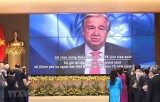Binh Duong to build up e-government
To implement the 10th Provincial Party Resolution, tenure 2015-2020, provincial Department of Information and Communications advised Provincial Party, Provincial People's Committee (PPC) to perform tasks of information technology (IT) application and development at the request of Resolution No. 36-NQ/TW on 1 July 2014 of the Politburo, Program No. 08-Ctr/TU on 18Feb 2016 of Provincial Party, Plan No. 1404/KH-PPC on 10 May 2016 of PPC, and Resolution No. 17/NQ-CP of the Government on several main missions, solutions for e-government development phase 2019-2020, oriented towards 2025. In the beginning, Binh Duong has gained some important results...

Department of Planning and Investment solved online documents through provincial enterprise database management system. This made a breakthrough in building an e-government to serve people and businesses.
Determination in direction
Lai Xuan Thanh, Director of Department of Information and Communications, said that the province issued a number of documents, regulations, creating a legal corridor to motivate the application as well as building e-government. Namely, the regulation of IT application in provincial State agencies was issued according to Decision 02/2013/QD- UBND. In 2011, Provincial People's Committee issued a "Roadmap to provide online public services" with the goal of completing the provision of 19 key public service groups by 2015, completing communal public services by 2020, provision of some level-4 public services and interconnected online public services. In 2016, Provincial Party Committee issued Action Plan No. 08-CTr/TU to implement Resolution No. 36-NQ/TW of the Politburo (11th term) to be the basis for the provincial e-government architecture under Decision No. 3004/QD- UBND dated October 25, 2018.
From these guiding documents, Binh Duong established a Steering Committee for the construction of e-government and smart city in Binh Duong province under Decision No. 3612/QD- UBND dated December 19, 2018; the division of duties and roles in e-government construction. Departments, branches and district-level People's Committees implement specialized systems by themselves. Department of Information and Communications implements shared systems, such as: Document management software, OSS software, online public service website, information response system for people, and synchronous connection between systems. Department of Information and Communications is assigned to conduct technical appraisal of IT application projects; must ensure that the implementation is consistent with the provincial e-government architectural framework.
The numbers as "leverage"
From practical steps, up to now, Binh Duong has gained many good results in building e-government at State agencies. Specifically, technical infrastructure for IT application in administrative agencies at all levels is invested quite fully. The province built two data centers for e-government and transmission of TSLCD network covering the commune level since 2015; 100% of provincial, district and commune agencies invested in a complete internal network system. Information security equipment are specialized and modern. The public e-mail system operates with over 6,900 5GB mailboxes; 94% of civil servants often use official mailboxes for work. Online video conference has been invested in phase 1 at 13 points at provincial level, all points at district and commune level; Phase 2 has been expanded to cover all communes, wards and towns in the province with 110 points.
Mr. Thanh added that operational software have also been employed by agencies for professional computerization, namely: Land information system of natural resources and environment sector; management software for officials of the internal affairs sector; digitization of data of the labor - invalids and social sectors, archives, resources - environment, planning and investment, provincial libraries; Enterprise database management information system of the province created by Department of Planning and Investment; urban planning information management system implemented by the Department of Construction; database management system for industry and trade sector, health sector, education and training sector...
Binh Duong built an electronic portal and has been upgraded since 2015, meeting the content requirements of Decree 43/2011/ND-CP and technical standards of Ministry of Information and Communications. The portal is the official information channel of the provincial government, reaching 1 million hits/year. In 2017 and 2018, Binh Duong electronic portal was in the top 63 provinces and cities ranked by Ministry of Information and Communications. OSS software has been implemented from 2009 to present, is regularly upgraded with features to serve people and businesses. This software has been applied uniformly in all 20 departments, branches, 9 People's Committees at district level and 91 People's Committees at commune level; provides utilities for handling records, responding to status via messages, Zalo, assisting people and businesses in information search.
The provincial public service portal at https://dichvucong. binhduong.gov.vn was built very early and continuously upgraded to meet technical standards of the Government. The portal is a people-centered information channel with a minimalist orientation, and helps people easily find and use utilities to serve the process of interacting with State agencies.
Consent and contribution
Over 10 years, shared and specialized information systems have gradually realized components in the e-government architecture of Binh Duong province with LGSP axis, which plays the role to connect, synchronize data among internal components of the e-government and with systems of ministries and central branches. The most outstanding accomplishment of provincial e-government are public services provided for people and businesses. According to evaluation of the Government's office, Public services and OSS portal of Binh Duong province has been regularly in top list of provinces and cities that most effectively implement the integrated into National Public service portal.
Provincial e-government completed Phase 1 and is entering Stage 2. Mr. Thanh said that in order to complete the e-government and progress towards a digital government before 2025, Provincial Party, PPC needed to direct bodies, district and commune level to perform a number of tasks and solutions. It is programs to enhance awareness, skills training on digital transformation, development of digital government for civil servants in state agencies. The key for digital transformation to agencies and organizations is not technology, but is the human factor, model, process, use of platforms. Development of the digital Government's infrastructure to serve state agencies must combine strengths of the TSLCD network, the Internet, and provincial Data center; enhance the capability of providing virtualization and cloud computing services of Data centers for efficient connection, management of resources and data at state agencies.
In addition, there are non-cash payment system for direct and online public services; By the end of 2021, 100% of public services to reach Level 3, Level 4; Construction of electronic authentication systems pursuant to Decree 45/ND-CP dated 8 April 2020 of the Government for the implementation of administrative procedures on electronic environment. In parallel, it is the standardized, electronic process of record and dossier settlement; development of information systems for meetings and handling works of provincial People's Council, provincial People's Committee, district level; To build a local report information system with connection, integration with information systems, reports of the Government; Digitalization of records, archive of electronic records of State agencies; application of the latest technologies on social media, big data analysis, artificial intelligence...
Reported by Ho Van - Translated by Ngoc Huynh
 Vietnam – Malaysia relations develop strongly in new period
Vietnam – Malaysia relations develop strongly in new period
 Youth Union enhances propaganda on all-level Party Congress
Youth Union enhances propaganda on all-level Party Congress
 Provincial Party Committee announces personnel decisions
Provincial Party Committee announces personnel decisions
 Provincial delegation pays working visit to Germany
Provincial delegation pays working visit to Germany
 Provincial People's Council Chairman takes part in "Morning Coffee - Exchange with people" in Hiep Thanh ward
Provincial People's Council Chairman takes part in "Morning Coffee - Exchange with people" in Hiep Thanh ward
 Honoring traditional values, strengthening solidarity
Honoring traditional values, strengthening solidarity
 Igniting, promoting the strength of great national solidarity
Igniting, promoting the strength of great national solidarity
 State President concludes official visit to Peru, attendance at APEC Leaders’ Week
State President concludes official visit to Peru, attendance at APEC Leaders’ Week
 State President’s Chile, Peru trip a success: official
State President’s Chile, Peru trip a success: official
 PM’s trip to bolster Vietnam-Brazil comprehensive partnership
PM’s trip to bolster Vietnam-Brazil comprehensive partnership




